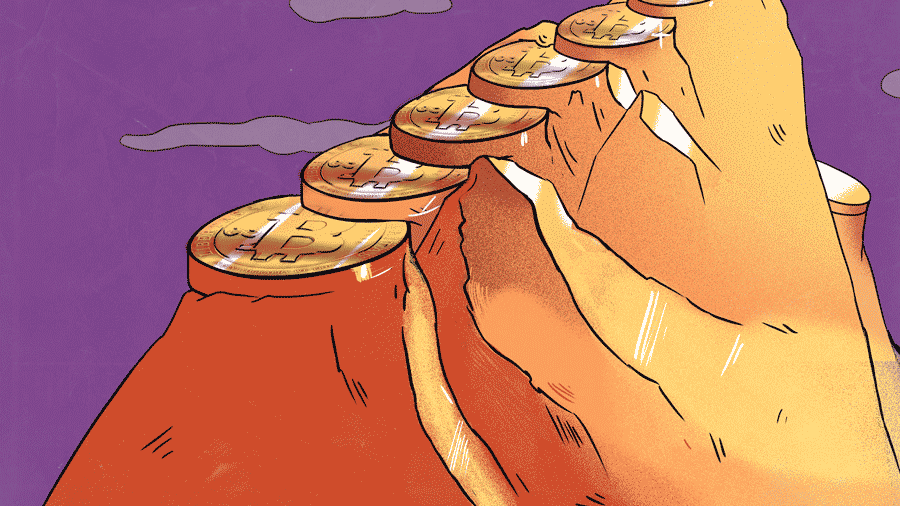By most metrics, 2021 has been an astonishingly successful year for Bitcoin.
In price terms, the world’s best-known and most valuable cryptocurrency has climbed from around $29,000 at the start of the year to a fresh all-time high of nearly $70,000, and in the process reached a market cap of more than $1 trillion for the first time.
Subscribe to the Crunchbase Daily
Price, however, has only been one part of the story.
Institutional adoption and mass recognition
Setting aside the matter of price for a moment, 2021 was Bitcoin’s most important year to date, not least due to rising institutional adoption and increased mainstream recognition.
Following the playbook of MicroStrategy’s outspoken CEO Michael Saylor, who continued to strengthen the company’s Bitcoin position via a series of convertible note offerings, this year saw Elon Musk add “digital gold” to the balance sheet of Tesla and SpaceX, as well as establish his own personal position.

Elsewhere, the crypto asset witnessed increasing endorsement from some of the world’s most successful investors and hedge fund managers. Endowment funds, insurance companies, banks and payment processors like PayPal all ramped up their investments or service offerings, reversing a previous skeptical stance on the new asset class in the wake of regulatory clarity on custody and a macro environment of rampant money printing.
Ben Caselin, head of research and strategy at AAX, a leading crypto exchange, notes on the matter: “We’re seeing the adoption of Bitcoin by institutions and even countries. As the asset class grows in market cap and sophistication, those who dismissed it before due to its small size are now forced to reconsider their assessment. JPMorgan never supported Bitcoin, until they had to. It will be no different with hedge funds, sovereign wealth funds, central banks, and governments. Anyone who expects continued growth is able to buy Bitcoin or place it on their balance sheets, and that is exactly what has been happening in 2021.”
Traditional financial instruments providing exposure to Bitcoin, such as the CME’s futures contracts, grew significantly, and Grayscale’s GBTC product attracted plenty of investment in the early part of the year. This ultimately led to the approval of the oft-mooted Bitcoin ETF by the U.S. Securities and Exchange Commission, albeit futures rather than spot-based.
And of course, who could forget El Salvador breaking the mold by becoming the first nation to make Bitcoin legal tender? In leveling-up the game theory of Bitcoin as a monetary standard, and just recently outlining a volcano-powered, tax-free Bitcoin City, El Salvador’s bold leader Nayib Bukele allowed the country to break free from outsourced control of dollarization and immediately enhanced the country’s $6 billion remittance market.
Paradoxically, the best thing to happen to Bitcoin in 2021 might have actually been the source of extreme fear, uncertainty and doubt (FUD) at the time.
The China ban
It feels like there has been a Chinese Bitcoin ban of some description for every year of the asset’s existence, and in May 2021, the latest and arguably final target was Bitcoin mining. And it came at a bad time. Elon Musk had gone from Bitcoin hero to villain, u-turning on Tesla’s prior decision to accept BTC as payment for its vehicles, citing concerns that mining was harmful to the environment. FUD seized the market as mainstream media gratefully jumped on the narrative.
While many blamed Musk, it was the China ban doing the real damage. Bitcoin miners were forced to power down all over China and either liquidate their businesses or decamp to friendlier jurisdictions. In tandem with an environment of fear and over-leveraged derivative positions, the price of Bitcoin over the summer months as the global hash rate dropped by more than 50 percent.
The result was not only the end of China’s once-dominant Bitcoin mining position—reportedly constituting over half of the global hash power—but its near eradication.
China out, US in
As the subsequent recovery in both price and hash rate demonstrated, Bitcoin simply doesn’t care. Undeterred, it continued to add blocks and serve millions of users disillusioned with the fiat standard. This latest ban, it was soon clear, was a huge geopolitical misstep by the Chinese Communist Party.
China’s crackdown forced greater global decentralization of mining operations, with miners relocating to places like the U.S., Kazakhstan, Canada and Russia. It also removed the largest share of the global hash rate out of an authoritarian regime with potential for confiscation, and destroying historical anti-Bitcoin arguments centered around China’s share and supposed control of the market.
In a matter of months, the U.S. became the new dominant Bitcoin mining location, according to figures from the University of Cambridge Centre for Alternative Finance. Amazingly, Xi Jinping had handed over a sizable share of this rapidly expanding industry to China’s greatest geopolitical rival.
The fact that so much mining infrastructure was shipped into the U.S. from China, alongside well-established existing operations on a more environmentally friendly grid profile, provided a major institutional acceptance boost to Bitcoin, helping to pave the way for a long-anticipated ETF approval.
Ironically, it also brought the wasteful energy narrative linked to the China ban full circle, with the likes of Saylor and Musk spearheading a renewable energy movement that is driving Bitcoin mining to be greener and cleaner. That’s despite it already having some of the highest levels of renewable energy sources compared to other industries, including the traditional banking system.
Crossing the chasm?
As we close out 2021 and look ahead to 2022 and beyond, where is Bitcoin heading?
Time will tell, though 2022 is likely to deliver more of the same. Educational, custodial and regulatory clarity will bring in more institutional interest, including the huge pension fund market. More states and nation-states will probably start to follow at least part of the El Salvador playbook. And the elusive spot ETF may finally arrive for a Bitcoin market increasingly perceived as “made in the USA.”
While regulatory approvals and institutional adoption bring in big money, awareness and growth, the resulting products run counter to the ethos of Bitcoin as peer-to-peer decentralized money. However, Bitcoin itself unlocks financial sovereignty for the individual that cannot be changed or controlled by such interests—as this year has clearly demonstrated.
What is perhaps more interesting is that with an adoption rate twice as fast as the internet (roughly doubling year on year), and recent reports suggesting it has reached levels as high as 16 percent in the U.S., Bitcoin is crossing the chasm into the early majority phase, on track to reach mainstream adoption of 1 billion users by 2025.
Reuben Jackson is a blockchain security consultant, helping organizations with data structures. Jackson reports and writes opinions on the blockchain/crypto space. He previously wrote about CBDCs, NFTS and crypto regulation for Crunchbase News.
Illustration: Li-Anne Dias

Stay up to date with recent funding rounds, acquisitions, and more with the Crunchbase Daily.




67.1K Followers